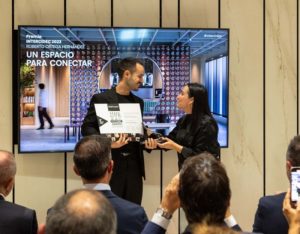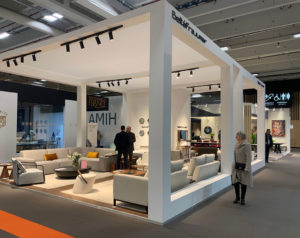How did you realise you wanted to go into architecture and interior design?
I am the daughter of an architect, growing up in a house specially designed by my father. My environment and my artistic aptitudes have always led me down the path of art and architecture.
I have always liked what happens around human beings at an urban level (I am a qualified urban architect), how they move, how they relate to traffic, leisure areas, green areas, the neighbour opposite; as well as what happens closer to them, the proportions of a room, the height of the back of the chair, the shape of the seat, the atmosphere of the room, lighting, colour, the mood in the home, and equally in a public place, how to create a party atmosphere, or a calm atmosphere, depending on the case.
Theming a space is a nice challenge.
How did you get started in the world of design?
I have always painted and made handicrafts. Every weekend of my childhood was spent trying out new techniques. This has always led me to experiment with a variety of materials, to touch them, to feel them, to get to know them.
Besides, I have always liked industrial design and I have always wanted to innovate and experiment, I even competed making a lamp with an ostrich egg.
Since my beginnings in the world of work I have had the opportunity to carry out interior design reforms and this has been growing until nowadays I dedicate myself almost 100% to it.
I am grateful that both my father, as the initiator, and my later superiors have supported my imagination. It has been of crucial importance the open-mindedness of the promoters of the works, thinking that design was a point of value in their business.
What have been your sources of inspiration?
I get sources on many fronts. I am observant and retain a lot on a visual level. Performances, painting, photography, nature, a theatre play, a film, a tile, a fabric, you can’t close yourself off to anything.
Each project requires a new thought, a new story, and the sources are focused on one side or another according to the needs of the project. In one project it could be a tack from a jacket and in another the toquilla of a fallera or in another a giant kite.
What do you consider that characterises you personally and helps you to achieve your results?
My constant work, my incessant search for new ideas, to create new experiences. I like to surprise, to do something different from what we are used to. This happens to me on a personal level, I’m always looking for new ways to reach my goal.
What do you look for in each new project?
To reach the objective of the developer and the end client, to surprise them, to make them remember where they have been and the experience they have lived in the designed place. That they get into the history created and live it. And, of course, to innovate and surpass myself.
What are you most passionate about when you start a project?
New things, above all. Each project is a new starting point for a fantastic story. If the project is also a team project, all the better, so we all feed off each other’s opinions and the project becomes a beautiful struggle towards a common goal.
Which project have you enjoyed the most?
I had the opportunity to collaborate in the creation of the Ushuaïa Tower Hotel and the Hard Rock Hotel in Tenerife. Both hotels have a client who wants to have a good time and wants to be surprised in a crazy atmosphere.

Ushuaïa Tower Hotel and Hard Rock Hotel, Tenerife.
It was a lot of fun and a rewarding experience on a personal and professional level.
What do you consider to be the most difficult thing about interior design?
First of all, that the developer understands that interior design is one of the keys to his business, that it is not a question of putting in a lamp but of creating an atmosphere. As an architect, I always have to think about the whole of the envelope, its installations, its regulations, while at the same time creating a suitable atmosphere for each challenge.
I like to treat the space in a global way, thinking from the beginning about the type of lighting, the atmosphere, the business that takes place in this space.
Once the promoter is convinced, the second difficult issue is to create the right ambience so that the client gets to feel the target experience.
What would you highlight most from your experience on the jury of our InterCIDEC 2018 Competition??
First of all, I would highlight the company Beltá Frajumar for the initiative to promote this competition and promote good design.
There was a lot of talent in the competition, and this talent is often hidden because there is no opportunity to bring it to light.
Giving the opportunity to bring together young designers with brands of lighting, vinyl, carpets, etc., together with established designers and entrepreneurs in the sector seemed to me to be a great contribution to our sector.
What do you value most about Beltá Frajumar?
It’s people, its workers, its good atmosphere. I feel like a team when I work with them.
I value very much the opinion of its professionals, and the spirit and joy with which they take on a new challenge.
In addition to their own furniture designs, it is worth mentioning their ability to bring to reality all the furniture created by us designers and to go down to the last detail.
How would you define in one word the feeling you had when you were told that your project was selected for the Hostelco Awards 2020?
WOW!
What does it mean for you to be awarded by Hostelco Awards 2020?
The award was given for the refurbishment of a Marriott hotel that we carried out together with Fraile Project, a hotel that had lost its rank, and we managed to get it back to be flagged by the brand, quite a challenge.
It was the first project for ourselves in our career after having collaborated in several studios, so the joy was immense.
This has put me and the studio I work with Antonio Albaladejo in an important position in the Spanish studios.
What is the next project you are most excited about?
Well, after this health and financial crisis, it seems that other new projects are starting.
I would like to be able to continue in the line of fun and crazy hotels, where creativity has its maximum value and to work again with a great team where we share ideas and smiles.
What do you think has made the difference during this 2021 in your studio?
The award came in the middle of a pandemic and financial crisis, so the bombshell that could have been the announcement of this Hostelco award and meeting people related to it at the awards party faded away.
This year has served to continue learning (I have already achieved my second master’s degree in interior design), to consider the future, the path to follow, to compete, and to expand collaborations. It has also served to reflect on certain design themes that have now been touched by the virus: materials, routes, timetables, new experiences, confluences, coexistence.
We have taken the positive side out of the negative.
What would you say to young people who are just starting out in this beautiful profession?
I would encourage them to think beyond, to reflect on human beings and their behaviour and to create new experiences that make us enjoy ourselves and open our minds.







